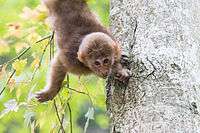Tibetan macaque
| Tibetan macaque[1] | |
|---|---|
 | |
| Scientific classification | |
| Kingdom: | Animalia |
| Phylum: | Chordata |
| Class: | Mammalia |
| Order: | Primates |
| Family: | Cercopithecidae |
| Genus: | Macaca |
| Species: | M. thibetana |
| Binomial name | |
| Macaca thibetana (Milne-Edwards, 1870) | |
 | |
| Tibetan macaque range | |
The Tibetan macaque (Macaca thibetana), also known as the Chinese stump-tailed macaque or Milne-Edwards' macaque, is found from eastern Tibet east to Guangdong and north to Shaanxi in China. It has also been reported from northeastern India,.[2][3] This species lives in subtropical forests (mixed deciduous to evergreen) at altitudes from 800 to 2,500 m (2,600 to 8,200 ft) above sea level.
Taxonomy
There are four recognized subspecies:
- M. t. thibetana
- M. t. esau
- M. t. guiahouensis
- M. t. huangshanensis
Physical description
The Tibetan macaque is the largest species of macaque and one of the largest monkeys found in Asia. Only the proboscis monkey and the larger species of gray langur come close to match their size among Asian monkeys. Males are the larger sex, commonly attain a weight of 13 to 19.5 kg (29 to 43 lb) and length of 61 to 71 cm (24 to 28 in) long, with a maximum record weight of 30 kg (66 lb). Females, in contrast, weigh 9 to 13 kg (20 to 29 lb) and measure 49 to 63 cm (19 to 25 in) long. The stump-like tail adds only 4 to 14 cm (1.6 to 5.5 in), with females having a considerably shorter tail.[4][5] The fur is well-suited to the species' cold environments being long, dense and brown on the back with creamy-buff to grey coloration on the underparts. Some adults are quite dark brown on the back, while others are basically a sandy yellowish-brown color. They have a prominent, pale-buff beard and long whiskers, but have a hairless face. The face is pale pinkish in males but is a more vivid, reddish-pink in females. The infants have silver-and-black fur that changes to its adult color at the age of two.[6]
 Male Tibetan macaque.
Male Tibetan macaque. Female Tibetan macaque breastfeeding infant.
Female Tibetan macaque breastfeeding infant. Young Tibetan macaque.
Young Tibetan macaque.
Behaviour
The Tibetan macaque lives in mixed sex groups. In their complex social system, females remain for life in their natal group, but males disperse shortly after their adolescence (at about 8 years old). Macaque societies are hierarchical, with higher-ranking males getting better access to the resources, namely food and sexually-receptive females. Alpha males dominate the group, being those that are typically large, strong and newly mature. As they age, males tend to gradually lose their social standing and are frequently subject to challenges for dominance from other males. Such conflicts are frequently quite violent and males may kill each other in battle. Studies of Tibetan macaques at Mount Emei and Huangshan Mountains, China, found the average tenure for an alpha male only lasted about one year. When troop size becomes quite large (in the 40 to 50 range) and competition grows over increasingly stretched resources, some individuals (males, females and juveniles) split from the main group to form a new, smaller group, known as 'fissioning', and move on to a different home range. Usually, it is the lowest-ranking individuals that will split from the main group.[6]
Females first breed at around five years of age. The gestation period is six months with a single offspring being produced at each pregnancy. Most infants being born in January and February. Young macaques are nursed for a year and may continue to do so longer if the female does not give birth again the following year. Males of the group may also be involved in alloparenting care.
This diurnal species spends most of its time on the ground, where it forages for leaves, fruit, grass and, to a lesser extent, flowers, seeds, roots and insects. When available, bamboo shoots, fruits and leaves are particularly favoured.[6]
Conservation
This species is classified as Near Threatened by the IUCN and is listed on Appendix II of the CITES list. Its main threats are all human-related. Principally, they are sensitive to habitat destruction, as they are tied closely to the forest. They are occasionally poisoned by herbicides and pesticides while eating and may catch diseases transmitted from humans. Illegal poaching may occur, with the flesh and the fur of the macaque being used.[6]
References
- ↑ Groves, C.P. (2005). Wilson, D.E.; Reeder, D.M., eds. Mammal Species of the World: A Taxonomic and Geographic Reference (3rd ed.). Baltimore: Johns Hopkins University Press. p. 164. OCLC 62265494. ISBN 0-801-88221-4.
- 1 2 Yongcheng, L. & Richardson, M. (2008). "Macaca thibetana". IUCN Red List of Threatened Species. Version 2008. International Union for Conservation of Nature. Retrieved 4 January 2009.
- ↑ Kumar, R. S.; Mishra, C.; Sinha, A. (2005). "Discovery of the Tibetan macaque Macaca thibetana in Arunachal Pradesh, India" (PDF). Current Science. 88 (9): 1387–1388.
- ↑ Zhao, Qi-Kun (1994). "Seasonal changes in body weight of Macaca thibetana at Mt. Emei, China". American Journal of Primatology. 32 (3): 223–226. doi:10.1002/ajp.1350320309.
- ↑ Andrew T. Smith; Yan Xie; Robert S. Hoffmann; Darrin Lunde; John MacKinnon; Don E. Wilson; W. Chris Wozencraft (15 May 2010). A Guide to the Mammals of China. Princeton University Press. pp. 34–. ISBN 978-0-691-09984-2. Retrieved 21 August 2012.
- 1 2 3 4 Tibetan macaque videos, photos and facts – Macaca thibetana. ARKive (2006-12-22). Retrieved on 2012-08-21.
External links
| Wikispecies has information related to: Tibetan Macaque |
